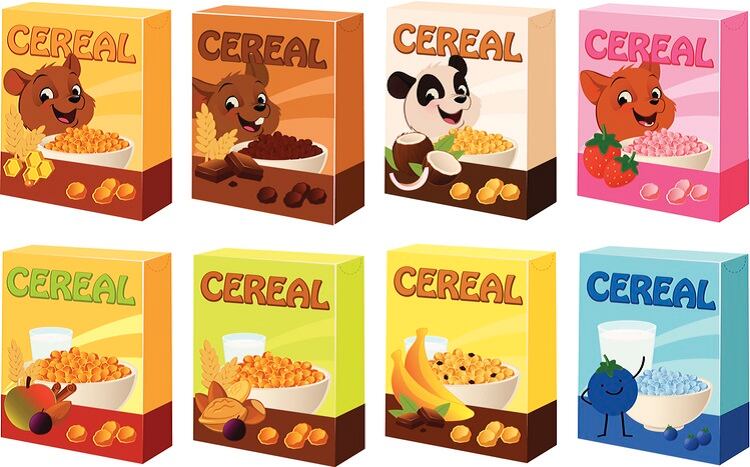Poor diet and nutrition are recognised as major contributory risk factors for ill health and premature death in the UK.
While Public Health England (PHE), the body that advises the British government on public health policy for all of the UK, has attempted to address these issues by inciting manufacturers to reduce added sugar content in processed foods by 2021, a recent survey has revealed that breakfast cereals are “still shockingly high in sugar”.
The survey, released today (26 February) as part of the Food Foundation’s annual State of the Nation’s Food Health report, categorised 77 breakfast cereals with brightly coloured packaging appealing to children. The audit was conducted in November 2018.
Three colour categories – red, amber and green – have been used to designate the amount of salt and sugars per 100 g of each cereal product, based on their front-of-pack colour-coded nutrition labelling.
UK campaign groups, Action on Sugar and Action of Salt – which initiated the survey – also created scoring for fibre.
SUGARS: Red > 22.5 g, Amber > 5.0 to ≤ 22.5 g, Green ≤ 5.0/100 g
SALT: Red < 1.5 g, Amber < 0.3 to ≤ 1.5 g, Green ≤ 0.3/100g
FIBRE: Red < 5 g, Amber ≥ 5.0 to < 10g, Green ≥ 10 g/100 g
Sugar and salt ‘offenders’ named and shamed
Looking at the sugar numbers, 38 out of 77 products surveyed, or 49%, were placed in the red category for their high sugar content per 100 g.
According to the Action groups, the “worst offender” was ‘Malt O Meal Marshmallow Mateys’. Made by US manufacturer MOM Brands Company, the breakfast cereal contains 40% sugar.
‘Morrisons Choco Pillows’ came in second place with 36%, followed by ‘Sainsbury’s Frosted Flakes’, which contains 34% sugar.
The campaign groups raised concerns that all three products contain more sugar than Milk Chocolate Digestive Biscuits. In addition, of the remaining products, 48% received amber labels, with just two receiving green.
While focus on salt content in breakfast cereals has traditionally been overshadowed by sugars, these recent survey results reveal salt reduction remains an issue in the children’s food sector.
65 of the 77 breakfast cereals received an amber designation, with some products found to contain more salt than ready-salted crisps. Just 11 breakfast cereals received a green label.
Again, ‘Malt O Meal Marshmallow Mateys’ took out first place with the highest amount of salt per 100 g – 1.6% – followed by Kellogg’s ‘Unicorn Froot Loops’ with 1.13% salt.
Fibre focus
The recommended fibre intake for a child aged 5-11 years is 20 g per day. While breakfast cereal has the potential to provide much of this recommended daily requirement of fibre, the survey revealed that many children’s cereals fail to offer adequate levels.
75 products (97%) contained 20% or less of the recommended dose of fibre per serving, with just one product providing more than 30% of the recommended daily requirement.
Cereals containing the lowest amount of fibre include Co-op Crispy Rice, with 1.4 g per 100 g, followed by Tesco Pillows Milk Choco Pillows with 1.5 g, and Asda Choco Squares with 1.6 g.
Tesco Pillows Milk Choco Pillows, however, is no longer available in packaging that may appeal to children.
‘Cereal packaging is like have giant billboards on the breakfast table’
The survey results have prompted Action on Sugar and Action on Salt to campaign for a ban on cartoons and bright packaging on these products, which can influence shopping habits, we were told.
“Whilst we can't reference specific sales data, cereal packaging is like having giant billboards on the breakfast table every morning – influencing consumption, awareness and future purchase,” nutritionist and campaign lead at Action on Sugar Kawther Hashem told FoodNavigator.
“This survey shows that companies that make packaging of unhealthy products targeted at children are completely irresponsible. It is immoral that breakfast cereals companies can get away with it, it is time we made it easier for parents and only allow those cereals which carry a green label to be allowed to feature cartoons on packaging which may appeal to children.
“In our view the government needs to ban use of such packaging on unhealthy products.” – Graham MacGregor, chairman of Action on Sugar and Action on Salt.
Hashem has suggested that healthy cereal manufacturers, rather than unhealthy food makers, make more of an effort to appeal to younger generations. “Children often influence what parents buy. Packaging that appeals to children, influences children’s choices and therefore their parents’.”
“There is a real opportunity for companies to put more child appealing packaging on products that are high fibre and low in fat, salt and sugar,” she continued.
Industry slow to respond to Public Health England target
PHE’s sugar reduction programme, which issued voluntary – rather than mandatory – guidelines to industry to reduce added sugar in popular products by 20% by 2021, may not be enough.
The programme received early success in the breakfast cereal category: at the end of the first year, manufacturers of breakfast cereals had cut added sugar by 5%.
But according to Hashem, more can be done at both an industry and regulatory level. “Why aren’t all cereal manufacturers reducing sugar levels as per PHE’s evidence-based recommendations and actively marketing healthier – those with green traffic lights for fat, salt and sugar – breakfast cereals to parents and children?”, she asked.
“We must have more enforcement of mandatory targets for products with packaging that appeals to children, particularly given the slow response by certain food manufacturers to the current voluntary programmes set by PHE.”


